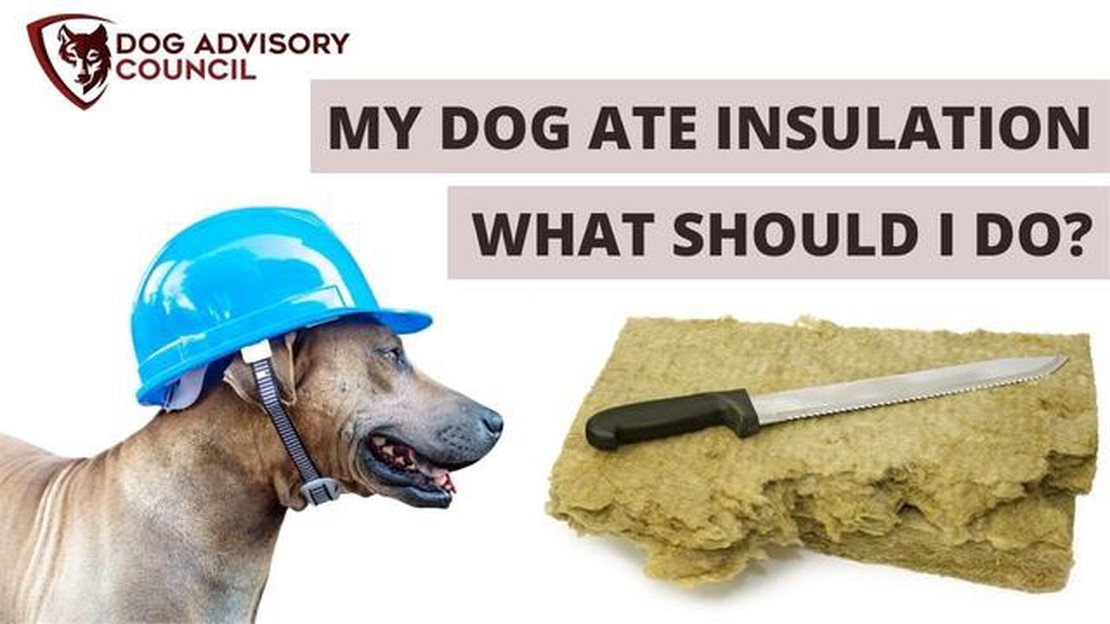How to Make Homemade Dog Ear Cleaner with Coconut Oil
Homemade Dog Ear Cleaner Coconut Oil If you have a dog, taking care of their ears is an important part of their overall health and well-being. Regular …
Read Article
If your beloved furry friend has just ingested foam, it can be a cause for concern. Dogs are naturally curious creatures and can sometimes get into trouble by chewing on things they shouldn’t. Here are some tips to help you handle this situation:
Remember, every situation is different, and the advice provided here is not a substitute for professional veterinary care. Always consult your veterinarian for personalized guidance based on your dog’s health and circumstances.
If your dog has consumed foam, it is important to act quickly and appropriately to ensure their safety. Here are some tips for handling the situation:
Remember, the safety and well-being of your dog should always be the top priority. Seeking professional veterinary assistance is crucial when your dog has ingested foam. Prompt action and appropriate care can help ensure the best possible outcome for your furry friend.
To prevent your dog from eating foam in the future, here are some helpful tips:
By following these preventive measures, you can help ensure your dog’s safety and minimize the risk of them ingesting foam in the future.
Eating foam can pose several dangers to your dog’s health. It is important to be aware of these risks and take appropriate action to protect your pet.
It is crucial to monitor your dog closely and take immediate action if you suspect they have consumed foam. Contact your veterinarian for guidance and follow their instructions to ensure the safety and well-being of your pet.
Read Also: Can a Puppy Get Parvo After 2 Shots? Exploring Parvovirus Protection in Dogs
If your dog has ingested foam, it is important to monitor them closely for any signs of an emergency. While some cases may only require monitoring and home remedies, it is crucial to seek immediate veterinary assistance if you notice any of the following symptoms:
If you notice any of these signs, do not hesitate to contact your veterinarian or bring your dog to an emergency veterinary clinic. Prompt medical intervention is vital to ensure your dog’s health and well-being.
Read Also: Is Hose Water Too Cold For Dogs? Experts Weigh In
If your dog has ingested foam, it’s important to monitor their behavior and watch for any signs of distress or discomfort. Contact your veterinarian for guidance on how to proceed. They may recommend inducing vomiting or bringing your dog in for an examination.
Yes, foam can be harmful to dogs if ingested. It can cause blockages in their digestive system, which can be potentially life-threatening. It’s important to be cautious if your dog has eaten foam and seek veterinary advice to ensure their safety.
Signs that your dog may have eaten foam include vomiting, diarrhea, loss of appetite, abdominal discomfort, restlessness, and lethargy. If you notice any of these symptoms, it’s important to consult your veterinarian for further guidance.
It’s best to consult your veterinarian before attempting to induce vomiting in your dog. They will be able to assess your dog’s specific situation and provide appropriate advice. Inducing vomiting may be recommended in some cases, but it’s important to follow professional guidance.
If you suspect that your dog has a foam blockage, it’s crucial to seek veterinary help immediately. A blockage can be a serious medical emergency and may require surgical intervention. Your veterinarian will be able to evaluate the situation and recommend the appropriate course of action.
Yes, there are precautions you can take to help prevent your dog from eating foam. Keep all foam objects out of your dog’s reach, and supervise them closely when they are in areas where foam is present. It’s also important to provide your dog with appropriate chew toys and mental stimulation to help prevent destructive chewing behaviors.
While it’s not uncommon for dogs to chew on foam objects, actually ingesting foam is less common. However, it can still happen and pose a risk to their health. It’s important to be aware of the potential danger and take appropriate measures to prevent your dog from eating foam.
Homemade Dog Ear Cleaner Coconut Oil If you have a dog, taking care of their ears is an important part of their overall health and well-being. Regular …
Read ArticleWhat Happens If A Dog Eats An Oxygen Absorber Packet Dogs are known for their curious nature and tendency to explore their surroundings by sniffing …
Read ArticleDogs Can Eat Cabbage Many dog owners may wonder if it’s safe to share some of their favorite vegetables with their furry companions. Dogs have …
Read ArticleWhy Do Dogs Smell Vaginas Canine behavior can often be puzzling and intriguing to humans. One puzzling behavior in particular is when dogs sniff each …
Read ArticleWhat Happens If You Watch A Dog Poop Have you ever wondered what really happens when a dog goes to do their business? Watching a dog poop may seem …
Read ArticleWhy Does My Dog Snort Like A Pig It’s not uncommon for dog owners to be startled by their canine companions snorting like a pig. While it may seem …
Read Article